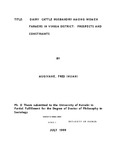| dc.description.abstract | The purpose of this study was to examine the role of women in livestock production, and
in particular dairy production, as a complimentary, income-generating activity which
significantly contributes to the overall productivity and food security. The specific
objectives were to document the development of dairy farming systems in Vihiga District;
identify the socio-economic characteristics of women small-holder farmers in the existing
dairy production system; determine the cost-effectiveness of zero-grazing systems as far as
the improvement of dairy production in the district is concerned and identify the
performance indicators of tile zero-grazing systems in the district. It was hypothesized
that the findings from this study could have implications for decision and policy makers
targeting women dairy farmers from a socio-economic perspective.
Low food crop production in the study area is due to overcultivated and exhausted soils.
Despite land scarcity in the densely populated area, dairy cattle are given less emphasis
because traditional livestocks are a form of life insurance for farmers. A technological
gap is perceived to exist between men and women farmers. The women farmers operate
under greater constraints than men. They have less access to information, technology,
land, inputs and credit yet they have primary responsibility for the home and child care.
Voluntary farm organization, technological adoption, environmental and gender
perspectives have been identified in this study as theoretical frameworks to women's role
ill agricultural activities. A socio-economic model has been conceived to show variables
that affect women's role in farm productivity.
Data were obtained from" randomly selected small-scale dairy holders, mostly women in
dairy zero-grazing production in Vihiga District of western Kenya. A master list of
women groups in zero-grazing was accessed from the Ministry of Agriculture Livestock
and Marketing, district livestock office at Vihiga and 18 women groups were randomly
selected from the list. A systematic (sequential) random sampling procedure was then
used to select the potential respondents numbering 105.
A descriptive analysis of the data collected on zero-grazing production systems among
women ill the district addressed socio-economic indicators of the farmers in the dairy
production. Although zero-grazing was found to be profitable and cost-effective for the
woman farmer to engage ill, reed, labour and veterinary service costs were found to be
major constraints in the system.
The data obtained from the respondents were further subjected to associations, multiple
regression and path analytical techniques in order to ascertain the influence of explanatory
variables in the empirical model s and variations in productivity as measured in net farm
income and number of grade cows owned by respondents.
Results indicated that women groups were the main sources for obtaining grade cattle.
Majority of the respondents were in the 30-to-50 years age category. Children's and hired
labour was found to be an important factor. Farm sizes were significantly associated with
grade cows and participation of the woman as a manager.
Respondents practiced agro-forestry and there was statistically significant association
between zero-grazing and purposes of practising agro-forestry. This was also explained
by the finding that area under fodder had the strongest effect on a number of grade cows
owned by respondents. The findings also showed explanatory variables (income, children,
labour cost, age) accounted for substantial proportion of the variation in dairy income. An
interesting finding was that formal education had little impact on grade cows ownership
and respondents above middle age were found to have positive and direct effect on
productivity. i
An important finding from these results is that women groups to which the respondents
belonged were the most frequent source of awareness and therefore adoption of zero-
grazing dairy systems. The organization of women into target groups, such as zero-
grazi ng women grou ps, bring with them thebenefits of economies of scale in the costs and
provision of extension services by ma11Y agents. It is recommended that:
Women groups be strengthened so as to be involved in food security and
agricultural income-generating activities such as zero-grazing;iii
(ii) The high costs associated with labour, feeds, veterinary services be addressed as
Ill(ljor, cons! rai nt s a fleeting adopt ion of zero-grazing; and
(iii) That both young and older women farmers be encouraged to adopt and manage
small-holder farm technologies.
The association's analysis showed that zero-grazing operation relied more on the presence of the ch i ldren 011 t he In rill. However, it was observed that the respondent's level of education was not signirl~alltly associated with zero-grazing operations.
Multiple regression results showed positive relationship between socio-economic . characteristics of the respondents and productivity. Age as a social variable was found to have a strong influence on income as older farmers tended to have higher gross incomes per year compared to younger farmers. Consistent with the aprior expectations was the finding that households with large family size tended to have lower gross income per year from zero-grazing operations compared to households with smaller family size.
The path analysis findings supported the results of the above quantitative analysis. The model sho\.vecl that respondents who were above middle age had positive and direct effect on productivity. Education of the respondent (woman) was found to have a negative and direct effect on annual gross income and owning grade cows had negative impact 011 II1Collle. These results were unexpected and interesting.
On the basis of the above results, a viable approach to increase household food security and income i~ 10 adopt improved land-saving technologies such as zero-grazing. An understanding of the fanners' socio-economic characteristics, experiences and farming practices is essential before the new technology is made available to the fanner. | en |

